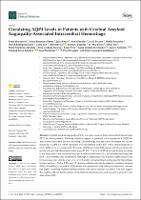Circulating AQP4 Levels in Patients with Cerebral Amyloid Angiopathy-Associated Intracerebral Hemorrhage
Author
Date
2021-03-02Permanent link
https://hdl.handle.net/11351/6568DOI
10.3390/jcm10050989
ISSN
2077-0383
WOS
000628314200001
PMID
33801197
Abstract
Cerebral amyloid angiopathy (CAA) is a major cause of lobar intracerebral hemorrhage (ICH) in elderly patients. Growing evidence suggests a potential role of aquaporin 4 (AQP4) in amyloid-beta-associated diseases, including CAA pathology. Our aim was to investigate the circulating levels of AQP4 in a cohort of patients who had suffered a lobar ICH with a clinical diagnosis of CAA. AQP4 levels were analyzed in the serum of 60 CAA-related ICH patients and 19 non-stroke subjects by enzyme-linked immunosorbent assay (ELISA). The CAA–ICH cohort was divided according to the time point of the functional outcome evaluation: mid-term (12 ± 18.6 months) and long-term (38.5 ± 32.9 months) after the last ICH. Although no differences were found in AQP4 serum levels between cases and controls, lower levels were found in CAA patients presenting specific hemorrhagic features such as ≥2 lobar ICHs and ≥5 lobar microbleeds detected by magnetic resonance imaging (MRI). In addition, CAA-related ICH patients who presented a long-term good functional outcome had higher circulating AQP4 levels than subjects with a poor outcome or controls. Our data suggest that AQP4 could potentially predict a long-term functional outcome and may play a protective role after a lobar ICH.
Keywords
Aquaporin 4; Cerebral amyloid angiopathy; Magnetic resonance imaging markersBibliographic citation
Marazuela P, Bonaterra-Pastra A, Faura J, Penalba A, Pizarro J, Pancorbo O, et al. Circulating AQP4 Levels in Patients with Cerebral Amyloid Angiopathy-Associated Intracerebral Hemorrhage. J Clin Med. 2021 Mar 2;10(5):989.
Audience
Professionals
This item appears in following collections
- HVH - Articles científics [4476]
- VHIR - Articles científics [1751]
The following license files are associated with this item:

 Private area
Private area Contact Us
Contact Us








